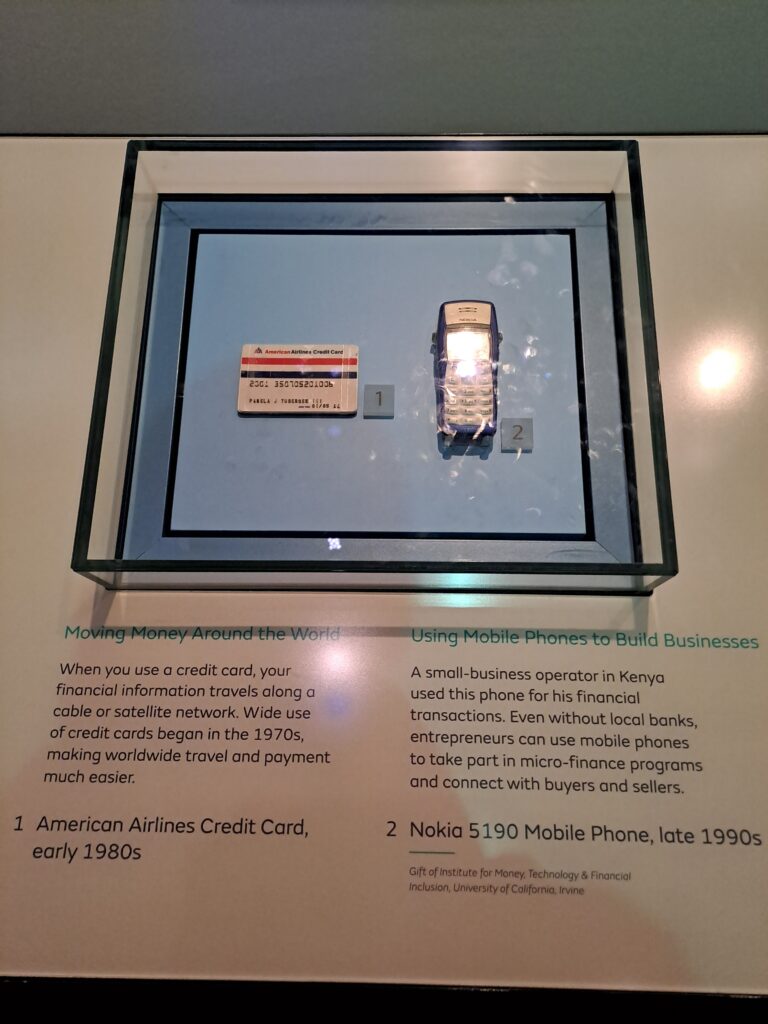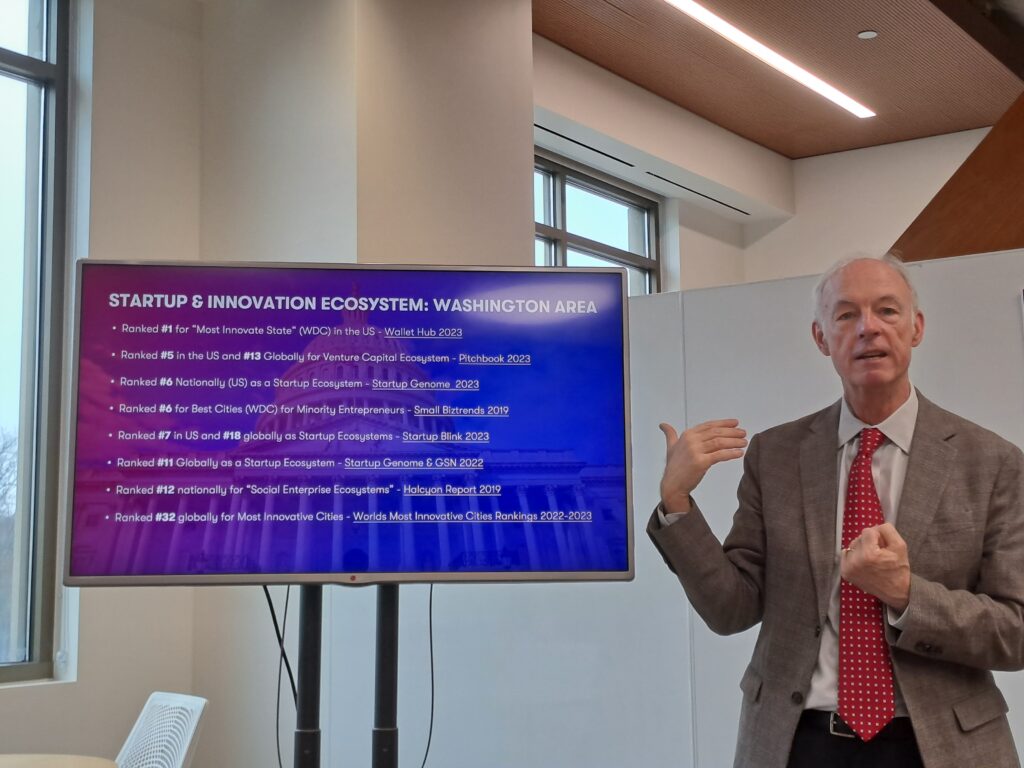Jussi Leponiemi, Key Account Director (ICT) at BusinessOulu, brings us his second report from the United States as he participates in the International Visitor Leadership Program.
When we talk about starting businesses and helping them grow, it’s clear that where you are and the country you’re in make a big difference. Different places have different systems and legislations that affect how businesses compare. But, even with these differences, there are some basic principles that most businesses follow, especially in Western countries. With all that in mind, here are a few things I learned from some of the numerous meetings in Washington about small business development and entrepreneurship. The persons mentioned in the article have all given their consent.
More pilots and explorations in policies
Our group gained insights into the United States’ system, context, and development, particularly focusing on the federalism of the country during a discussion with the esteemed expert Professor Emerita Catherine Rudder from George Mason University. While I won’t delve into the very details of this massive topic, I’d like to highlight a couple of key points from our conversation.
For context, it is important to understand that in the U.S. the majority of employees work for small businesses. However, there’s a noteworthy shift happening, with only two-thirds of new employees being hired by small businesses. The United States is a country with multiple layers of government, including states, districts, and cities, each having some degree of sovereignty. With over 20,000 governments in the country, there are continual elections taking place at various levels. This approach aims to distribute power, preventing excessive concentration in one institution.

From the perspective of small business development, it’s fascinating that local legislation varies widely. Businesses have the flexibility to choose the most suitable location for their particular needs. This stands in contrast to countries like Finland, where legislation remains consistent throughout the country, albeit with some special programs in specific areas. In the United States, the independence of different regions is more pronounced. This fosters a culture of experimentation and pilot programs even at the administrative level, extending beyond just small and medium-sized enterprise developmental aspects. States and smaller regions can try out new initiatives within their local legislation, creating a system that appears to be effective.
While the dynamic business culture in the United States is influenced by multiple factors, I would highlight the flexible and dynamic elements of the administration, allowing for experimentation, as a significant contributor. This aspect seems to be absent in many European countries to a similar extent.
Administration opens up access to capital
The notion highlighted in the previous chapter gained further significance during our meeting with Mr. Mitchell Harrison, a program analyst at the US Department of Commerce, Economic Development Administration (EDA). He provided insights into the specific grant investment programs conducted by the EDA in various parts of the country.
Why does this matter for small business entrepreneurs? Firstly, the EDA, alongside various other stakeholders, is constructing economic infrastructure designed to generate innovations stemming from regional strengths (see the below chart), with small companies being the primary participants and beneficiaries of these programs. Secondly, the EDA addresses a central challenge for small businesses: access to capital. They have established diverse funds tailored to small businesses, aligning this funding with other local small business financing mechanisms.

In summary, the United States is a highly business-oriented nation, leading to intense competition among states and cities for investments. This competition extends to legislative adjustments, driven by the desire for new jobs, innovations, developing ecosystems, and other positive outcomes. The emphasis on regional flexibility, coupled with active efforts by administrative institutions to build capital resources for small businesses, appears to be working quite well in the United States. While similar efforts are underway in Europe to some extent, there are undoubtedly valuable insights to be gained from the American experience.
Bring the VC in!

Enough with the context; let’s look into the business itself. Jeff Reid, Professor of the Practice of Entrepreneurship at the McDonough School of Business in Georgetown University, shed light on several insightful aspects of venture capital and its relevance for entrepreneurs. In many cases, the scalability and overall success of a company depends on the access to the capital. The foundational principles of the venture capital industry, as outlined by Reid, include: 1) embracing failure as an integral part of the process, 2) fostering a free market for talent, 3) genuinely sharing equity, and 4) showing disdain for hierarchy. In this context, venture capital refers to institutional equity investments in high-growth startups, where professional money managers, or VCs, play a crucial role, offering more value to entrepreneurs than one might imagine. Those four aspects outlined are excellent foundations also for any small businesses, when opened in depth.
We learned a lot regarding the nuances of VC equity and debt in various scenarios. We gained insights into VC perspectives on bootstrap and hockey stick growth settings, and how VCs assess the impact of their investment on a particular company at a specific moment in time. I believe that entrepreneurs, in general, stand to benefit significantly from this learning process. Regardless of the outcome—whether a founder secures VC funding or not—the thinking process is crucial and aids an entrepreneur in breaking out of potentially dangerous comfort zones.
For sure, it’s not an easy path. VCs typically focus on high-growth businesses and are often not the initial investors. History has taught us that not all high-growth companies require VC funding, and there are various alternative avenues for securing investments. One key takeaway from these meetings was the distinction between angel investors and VCs. Developing a strategy for navigating this landscape, considering factors such as syndication, dilution, and funding rounds, becomes imperative. Even if you never start a company, gaining an in-depth understanding of how VCs operate makes sense. For entrepreneurs, delving into the intricacies of their work is essential, as it forms a robust foundation for building a compelling business case.
Product first, then business? Incorrect!
One particular outcome that rose from many meetings was this: It’s still too common for companies to solely focus on their own product development without listening to their customers.
Several professionals I had the privilege of meeting emphasised the approach described below in this free quotation by Mr. Thomas White, Professorial Lecturer at the Department of Management in American University Kogod School of Business:
“We have seen it countless times in real life. Building something that isn’t perfect results in wasted time and money. Instead, avoid creating anything without customer consultations. Initiate work based on customer specifications, involving the customer in the process, and evolve from there. This marks a shift in mindset.”

This journey has only just begun with the first chapter, but I am already thoroughly convinced, once again, that going out, meeting professionals working with the same focuses and learning from others makes a lot of sense.
Br,
– Jussi Leponiemi


What is the International Leadership Development Program? Read Jussi’s intro blog to learn more.
